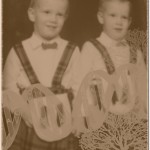Deep Ancestry and a Rediscovered Scottish Tribe
May 1, 2012 by ramona
Filed under Articles, Genealogy Technology, Introduction to Genealogy, Latest News
 Have you heard the term “Deep Ancestry” a process that uses both mtDNA and Y-DNA to find the most ancient roots on your family tree?
Have you heard the term “Deep Ancestry” a process that uses both mtDNA and Y-DNA to find the most ancient roots on your family tree?
This week Scotland’s DNA Project has come forward with some groundbreaking results using this process. Population Geneticist Dr. Jim Wilson of Edinburgh University along with journalist Alistair Moffat reported that the project has found one of Scotland’s long lost tribes.
The tribe called the Maeatae lived about 208 AD in the area around Stirling. History documents them in the works of the Roman writer Dio Cassius who recorded them as a hostile tribe living close to the Antonine Wall and in Adomnán’s Life of Columba (Saint Adomnán of Iona (627/8 – 704)). All references to the tribe disappeared after the 8th century…until now.
Moffat best known for his book The Scots: A Genetic Journey states “When the great Roman emperor Septimius Severus invaded Scotland with the largest army ever seen north of the Tweed, 40,000 legionaries and auxiliaries and a supporting fleet, he fought the Maeatae. They were mentioned by Roman historians as a fierce people and much later, noted by Adomnan, the biographer of St Columba. And then they disappeared from history,” Moffat goes on to say, “Now they are found. DNA has uncovered a high concentration of a distinctive marker clustered around Stirling and the foothills of the Ochils – the homeland of the fierce Maeatae. These are stories only DNA can tell.”
Other results from this study include:
- Nearly 100 distinctive Y-DNA groups have been found thus far
- One percent of Scottish men are descended from Tuareg and Berber Tribesmen of the Sahara
- The basic lineages of Scotland and England are similar
- Actor Tom Conti is a descendant of Napoleon Bonaparte
Test participants paid around 170 pound to have their DNA tested. From these, lineages were discovered for one Viking, one Arab, a Hebridean and three Saxons.
The future of the project promises even more excitement as Dr. Wilson reveals that they will be looking even closer at Neanderthal DNA in Scotland.
